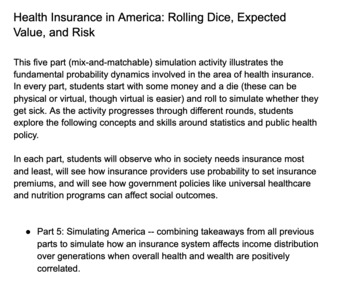Simulating Health Insurance in America: Probability, Binomials, Expected Value
- Google Docs™

Products in this Bundle (5)
Description
Health Insurance in America: Rolling Dice, Expected Value, and Risk
This five part, mix-and-matchable, large group simulation activity illustrates the fundamental probability dynamics involved in the area of health insurance. In every part, students start with some money and a die (these can be physical or virtual, though virtual is easier) and roll to simulate whether they get sick. As the activity progresses through different rounds, students explore the following concepts and skills around statistics and public health policy.
In each part, students will observe who in society needs insurance most and least, will see how insurance providers use probability to set insurance premiums, and will see how government policies like universal healthcare and nutrition programs can affect social outcomes.
- Part 1: Why insurance exists, simulation, basic probability rules, intuition of expected cost. (25 - 30min)
- Part 2: basic probability rules, the conditions, pdf, cdf, and mean of a binomial random variable, computing expected value, how aspects of the real world can be modeled by changing dice type (40min)
- Part 3: How insurance dynamics change if society has rich and poor classes who are equally healthy overall. (25-30min)
- Part 4: Adverse selection and how insurance dynamics change if society has groups of different overall health but equal wealth. (40min)
- Part 5: Simulating America -- combining takeaways from all previous parts to simulate how an insurance system affects income distribution over generations when overall health and wealth are positively correlated. (50-60min)


